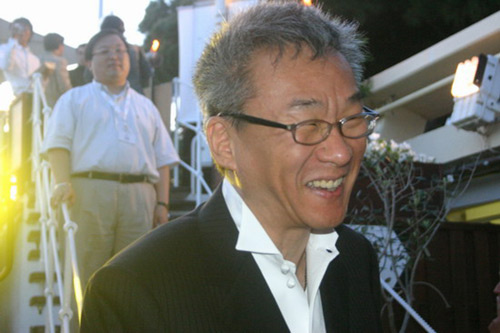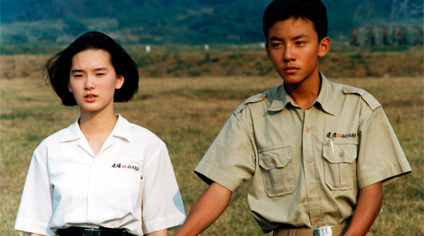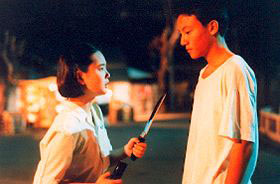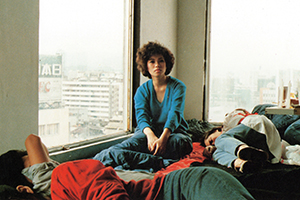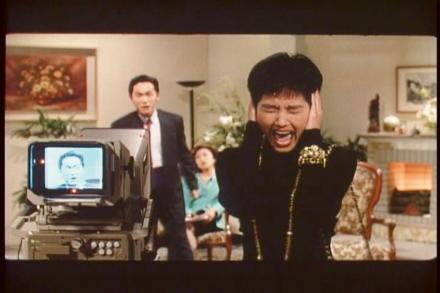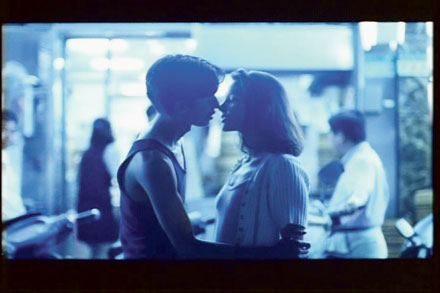From the Chicago Reader (November 7, 1997). — J.R.
The Films of Edward Yang
By Jonathan Rosenbaum
Taiwan is somehow within the world system as its citizens are in their city boxes: prosperity and constriction all at once; the loss of nature….What is grand and exhilarating, light itself, the hours of the day, is nonetheless here embedded in the routine of the city and locked into the pores of its stone or smeared on its glass: light also being postmodern, and a mere adjunct to the making of reproducible images.
— Fredric Jameson, “Remapping Taipei,” in The Geopolitical Aesthetic: Cinema and Space in the World System
These people have so much money stuffed up their ass it’s beyond belief! You know, in ten years this place [Taipei] will be the center of the world. The future of Western civilization lies right here. And you know what the odd thing is? We used to study history–the 19th century was the glorious age of imperialism, right? Just wait till you see the 21st century… — English character in Edward Yang’s Mahjong
The bombs we plant in each other are ticking away. — Edward Yang
During those rare moments of reflection when I’m not doing what film critics are supposed to be doing — watching and evaluating movies that propose various escapes from modern life — I wonder what a different kind of cinema might be, a cinema that would lead us back into the modern world and teach us something about it. To imagine such a cinema requires traveling some distance from where we are, spiritually as well as geographically; it means rediscovering versions of the past and future along with the present, and rediscovering the state of the planet not in terms of Americans but in terms of others who see both it and us with a kind of clarity we don’t have.
For the past decade I’ve been discovering clues about this new kind of cinema in two very different places, chiefly through the films of Abbas Kiarostami and Mohsen Makhmalbaf in Iran and Hou Hsiao-hsien and Edward Yang in Taiwan: all four have been redefining modernity in the world as well as in cinema. With the help of other filmmakers from the same countries (and I’m not counting the Taiwanese and Iranian directors who are interested in making Hollywood movies, the most successful of whom is Ang Lee), each pair has been charting a new field of inquiry and exploration between them.
It seems an unlikely pair of countries, given how little Iran and Taiwan seem to have in common. But recent art films in both have a relation to Italian neorealism and a relative freedom from the star system. In Iranian cinema, the new field of inquiry is the social impact of cinema itself, how it unites as well as divides people — a social fact that encompasses rich and poor, city and country, sacred and profane. Above all, inquiries are made into social space and physical landscape; sometimes “the cinema” figures only metaphorically or by analogy: it may be what a driver sees through the windshield of his car (as in Kiarostami’s latest film, The Taste of Cherry) or what a little girl encounters in the streets of Tehran during a continuous stretch of real time (as in Jafar Panahi’s The White Balloon).
By contrast, the principal discovery being made by Taiwanese directors is their own history — a discovery made possible by the recent loosening of Taiwanese censorship, making the country’s history a permissible subject for the first time. This new field of inquiry –w hich also involves a remapping of physical space — must negotiate the coexistence of colonizer with colonized; Confucianism with capitalism, democracy, and socialism; China with Japan and America; and personal identity with corporate and national identities. These densely layered “texts” ask to be read and reread.
Since 1985, when his A Time to Live and a Time to Die came out, only two of Hou’s seven films have been set squarely and exclusively in the present. By contrast, only two of Yang’s seven films to date qualify as period pieces: his first and shortest, the half-hour Expectations (1982), and his fifth and longest, A Brighter Summer Day (1991). Yet I’d argue that the two filmmakers are equally preoccupied with history; the sheer presentness of Yang’s contemporary films is every bit as grounded in the 20th-century history of Taiwan as the pastness of Hou’s period films is. All of them, to paraphrase Yang, are about the bombs we plant in one another, and all are historical in much the same way that Jean-Luc Godard’s contemporary films of the mid-60s were — as global newspapers that tell us what’s going on.
By and large, in both Iran and Taiwan, the members of each pair are rivals, even though they’ve influenced each other. They’ve even collaborated on the same picture — in both cases working on a single feature that eventually proved a watershed in their work. In 1985 (the same year he apparently came into his own with A Time to Live and a Time to Die), Hou starred in and collaborated on the script of Yang’s Taipei Story, a film that helped to change the face of Taiwanese cinema. And in 1990, Kiarostami made Close-up — a film partly about Makhmalbaf that features him in the closing sequence — which altered the face of Iranian cinema even more.
In each pair, one director is more traditional and closer to the working class (Hou, Makhmalbaf), while the other is closer to the middle class and more influenced by the West, especially European culture. Yang is as clearly marked by Michelangelo Antonioni (at least in a few of his films with contemporary settings) as Kiarostami is by Roberto Rossellini and Jacques Tati. (Yang, born in Shanghai in 1947 and mainly raised in Taipei, also lived for several years in the United States, getting a master’s in computer design at the University of Florida, then working as a computer designer for seven years in Seattle after a semester of film school at the University of Southern California; he returned to Taipei in 1981 to embark on filmmaking.)
Part of what’s valuable about these four directors is what’s also made their films relatively unmarketable here — meditative narrative rhythms combined with a preference for long shots and medium shots over close-ups, an approach that both assumes and encourages analytical distance rather than simple immersion in the action. (This principle is somewhat less marked in Makhmalbaf, but it’s still operative.) Despite resistance by most U.S. distributors and critics, however, all four directors have begun to make inroads here by virtue of their mastery and persistence. At least two films each by Hou and Kiarostami that have never had theatrical releases in Chicago are now available on video at Facets Multimedia, and Makhmalbaf’s Gabbeh opened here last summer.
Paradoxically, the most Western of the four, Yang, has had to wait the longest to reach Chicago. But for the past several years Barbara Scharres has been patiently and meticulously planning a complete Yang retrospective at the Film Center, which finally started at the beginning of this month and will continue for two weeks, capped by several appearances by Yang himself on November 21 and 22. In fact, this is probably the most comprehensive presentation of Yang’s work ever in the West, and thus represents a rare opportunity to see the films of an artist who may have more to say about the direction of modern life than any other filmmaker currently working.
The most novelistic of the four directors, Yang is also in some ways the most challenging: his complex plots typically incorporate several crisscrossing narrative strands; he dares us to keep track of them all. Of the four he’s also the one most fully engaged with the problems of contemporary urban life, and the one most preoccupied with the relationship between his characters and both architecture and objects. Yet apart from Fredric Jameson’s dense, suggestive study of Yang’s The Terrorizers (1986) quoted above, Yang’s cinema remains terra incognita in this country, though there have been a few festival showings; I can’t say that I know most of his films well because I’ve had to depend mainly on video copies to see them.
Nevertheless, I have no doubt that the 230-minute version of A Brighter Summer Day — which I was lucky enough to see in Taipei, and which will play at the Film Center on November 15 and 20–belongs in the company of key works of our era: Kira Muratova’s The Asthenic Syndrome; Bela Tarr’s Satantango; Kiarostami’s Close-up, Life and Nothing More, and The Taste of Cherry; and Hou’s trilogy — City of Sadness, The Puppet Master, and Good Men, Good Women. (I should add that, ironically, A Brighter Summer Day may also be the easiest of Yang’s features to follow as a narrative — even easier than the markedly different 202-minute version Yang was forced to create in order to find a distributor.) Indeed, Yang’s film surpasses these other masterpieces in its novelistic qualities, richly realizing a physical and social world as dense with family, community, and other personal ties as any John Ford film, and furnished with more sheer physical presence (including characters, settings, and objects) than any other fiction film I know of from the 90s. It took Yang four years to prepare — much of the time apparently spent training his superb cast, which is mainly composed of nonprofessionals. In fact, this film is so uncommonly good that Yang’s other very impressive works pale beside it.
A Brighter Summer Day was inspired by a true incident, a touchstone from Yang’s youth (though reportedly he’s transformed the event to the point where it bears little relationship to the original): the killing of a 14-year-old girl by a male high school student in Taipei on June 15, 1961. Yang frames the film with recitations over the radio of the names of students graduating from the same school in 1960 and ’61. (The school, which still stands in downtown Taipei, is one of the film’s central locations.) The title comes from the lyrics of the Elvis Presley song “Are You Lonesome Tonight?”–lyrics phonetically transcribed by the hero’s sister so that a younger friend, Cat, can learn to sing them. (Readers planning to see the film may want to skip the remainder of this section.)
The Elvis song is only one of many cherished artifacts belonging to the film’s characters that come from somewhere else. A samurai sword found by the hero, Si’r, in his family’s Japanese house, left by a former Japanese occupant, becomes the murder weapon, and a tape recorder left by the American army in the 50s records Cat’s version of the Elvis song. An old radio that for most of the picture doesn’t work because Si’r took it apart long ago, when his parents bought it, eventually broadcasts the list of graduating students (in this case the emblem comes from a different time rather than place). And a flashlight Si’r steals in the first extended scene from a film studio next to the school, where he periodically hides in the rafters to watch movies being shot, makes a fascinating progress through the film as intricate and various as that of any character.
That these objects come from elsewhere is central to the existential crisis undergone by all the characters, who have to grab a sense of self wherever they can find it. A charismatic gang leader in hiding who becomes a role model for Si’r describes spending most of his cloistered time reading “swordsmen” novels; he cites War and Peace as his favorite in that genre, and the only one whose title he remembers. Much later in the film, Si’r asks his sister, who’s trying to save him with her Christianity (another import), whether she’s ever read War and Peace. A Russian novel being seen as part of a Japanese tradition only begins to describe the cultural alienation and isolation of a country occupied by the Japanese and Kuomintang, not to mention the American army. By the same token, when Si’r and some of his friends go to see Rio Bravo, they seem as distant from the world of Hawks’s western as the central characters in Godard’s Contempt are from the Odyssey. (Another Hollywood film, The Misfits — alluded to in posters outside a theater — seems equally emblematic.)
The social landscape of A Brighter Summer Day is haunted, as Malaysian-born Chinese film critic Stephen Teo has suggested, by the absence of strong father figures. Similarly, Taiwanese identity is informed by a sense of perpetual exile: Si’r’s father is a civil servant who came to Taipei from Shanghai (as did Yang’s father), one of millions of mainlanders who fled the civil war in 1949. Si’r’s father is so weakened by the repressive thumb of the secret police and Taiwan’s militarized culture that he blames himself for his son’s failures at school, failures that actually stem from Si’r’s gang activities — which also clearly have grown out of an insecure sense of his own identity. (The father and son’s two memorable walks home from school with their bikes, each time after Si’r has gotten into serious trouble, touchingly recognize their shared vulnerability.) Ming — the sensitive, flirtatious, unstable teenager Si’r falls for — is growing up without any father at all and is saddled with a mother as vulnerable as Si’r’s father. As Teo writes, “Throughout the film, we get the feeling that Xiao Ma [Si’r’s best friend], Si’r, his family and most of his friends do not belong to Taiwan and are trying desperately to adapt.” Refusing to judge any of his characters, Yang accords them all a compassionate respect and understanding that compels us to share their dilemmas.
The Yang features set in the present that precede and follow A Brighter Summer Day also posit an alien, high-tech society where everyone and no one belongs. But Yang’s different stylistic approach to the roots of this condition in his epic and thematic “prequel” sets this film apart from those others. Jameson rightly sees The Terrorizers as bathed in a “postmodern” light, but this is mainly a nocturnal film defined by a no less postmodern darkness: enveloping pools of darkness, punctuated by beams from the stolen flashlight and other scattered forms of illumination, are extended by the power outages that, judging by this film and Taipei Story, are a distinguishing feature of Taiwanese life. The sense of an encroaching void broken by a few warm islands of light in which tenuous relationships flicker recalls Nicholas Ray’s Rebel Without a Cause in more ways than one. (Think of the planetarium sequence in Ray’s film and the extended stretch in the deserted house.) Indeed, imagine a Rebel that culminates with James Dean murdering Natalie Wood, then bewailing his loss, and you’ll get some measure of the tragic and lyrical despair underlying Yang’s vision.
What else can I recommend in this retrospective, based on my incomplete acquaintance with Yang’s work? I wouldn’t hesitate to call Taipei Story (1985, see below) a masterpiece, and A Confucian Confusion (1994) and Mahjong (1996) major works by any standard despite their difficulty. The only other Yang feature that remains to be shown is his first — That Day, on the Beach (1983) — which I’ve seen only on video and so don’t feel qualified to discuss. (Screen size, composition, and the relation of sound to image are so central to Yang’s art that not even letterboxed videos can do his work justice.)
Taipei Story is sustained in part by Hou Hsiao-hsien’s remarkable lead performance as a disillusioned textiles businessman, once an ace baseball player. It begins and ends with decorous, melancholy voids: Hou and his lover, a high-level executive, inspect an empty apartment in the opening, and the end juxtaposes a meaningless death with what seem like acres of new office space. In between, the couple’s relationship falls apart against a backdrop of speculation, failed businesses, and eerie new buildings waiting to be filled. Much as The Terrorizers evokes the chance encounters and ambiguous photographic images of Antonioni’s Blowup, this film about the interrelated perils of love and capitalism is periodically reminiscent of Antonioni’s Eclipse: the places occupied and unoccupied feel similarly haunted, and a constellation of characters both older and younger than the two leads extends the sense of malaise to other generations. Unfortunately this brief description makes Taipei Story sound more schematic and less poetic than it is; the moods it conjures up are potent and indelible.
In broad terms, A Confucian Confusion (see above) and Mahjong are rich orchestral versions of the same themes played as chamber music in Taipei Story — more intricate narrative mosaics also concerned about the effects of capitalism on personal relationships in Taipei. The more satiric of the two, the independently produced A Confucian Confusion, is set over a couple of frenetic days and weaves a web of romantic, sexual, and professional intrigues among an energetic businesswoman, her reckless fiance, a TV talk-show hostess, an alienated novelist, and an avant-garde playwright, among others. (Since Yang wrote and directed two plays between A Brighter Summer Day and A Confucian Confusion — the one-act Likely Consequence and the four-act Period of Growth — it’s tempting to read the playwright as a cruelly parodic self-portrait.)
In a statement printed in the press book for A Confucian Confusion, Yang describes the film’s philosophical and spiritual underpinnings in historical terms: “Like all the books on Chinese history we studied, over 2,500 years’ worth, and most of the recent Chinese-language films that depict the past, poverty and sufferings are central themes. Wealth was never really intended for the people in Confucian doctrines, which enforced more than anything else the central authority’s legitimacy with rigid social structures coated with moral justifications to stress conformism, discipline and personal sacrifices for social harmony and group security. Ironically, this conformism and discipline bore fruit to all these countries in their economic miracles and double-digit annual growths of the past two decades. Suddenly, as a result, we find ourselves in a position where we have run out of Confucian teachings, as well as Western solutions such as Democracy, from which to model ourselves. We may know how to tell the world what to do, as with the human rights issues, but do we know how to tell ourselves what to do for our own future? This confusion has created ever threatening anxieties in all the details of our daily lives.”
I can’t pretend to comment on the precise ways in which business dealings in present-day Taiwan interface with crime and vice versa, but clearly this interface is one of the subjects in both Mahjong and Hou’s most recent feature, Goodbye South, Goodbye. To some extent this interfacing can be found in every country (though what’s defined as “crime” in each clearly differs), but it has a particular impact in Taiwanese art cinema, some of which is financed by gangsters — a condition I’d wager won’t be found in most other countries (though it’s perhaps even more prevalent in Hong Kong). This fact plays into some of the ethical ambiguities Yang touches on in his statement. Put another way, some of the teenage gang members in A Brighter Summer Day appear to have grown up into the entrepreneurs in Mahjong. Unless my memory is playing tricks on me, “Redfish” is the name not only of an important character in Mahjong — the son of a tycoon who’s disappeared owing $100 million to local mobsters — but also of a gang member in A Brighter Summer Day.
Mahjong (see above) is Yang’s angriest and most provocative film, and also probably the one that’s elicited the most anger from viewers, especially in the West. Though I prefer it in many ways to A Confucian Confusion, it’s been widely criticized for something I like most about it — the inclusion of French, English, and American characters. Many have said that at least one of these parts is poorly acted — the English character quoted at the beginning of this review (Nick Erickson, a last-minute replacement for David Thewlis) — but that accusation strikes me as half wrong and three-quarters irrelevant. What’s valuable about these characters is the fresh and fascinating insights they provide into how Westerners–and westernization — might be regarded from a Taiwanese perspective. If this viewpoint strikes us as odd and oblique, I’m sure that’s no less the case when Asians see Asian characters in Western films. Acting styles in Western and Asian filmmaking are clearly not the same, and beyond this difference lies a collision of cultural identities close to the center of Yang’s frenzied maelstrom.
Critic Kent Jones has written about the effect of music on contemporary life and filmmaking — in particular, the cumulative effect of driving with the radio on — describing “the simultaneous feeling of driving and being driven” that has “created a new strain of narrative filmmaking that risks seeming weightless and uprooted in order to build from this new genre of modern experience.” Jones identifies this strain in such diverse films as Breaking the Waves, Irma Vep, all of Atom Egoyan’s movies, the recent work of Wong Kar-wai, and Yang’s last two features.
Alternating between the abrasive and the poignant, the sad and the terrifying, Mahjong offers a demonic tour of modern life that culminates in one of the most shocking, dramatically powerful murders I’ve ever witnessed in a film. This scene of forces spinning out of control virtually defines Yang’s dark sense of the present historical moment, even if he chooses to go beyond it and end on an unexpected grace note of tenderness and repose. Like the murder at the center of A Brighter Summer Day, this one resonates with tragic clarity as a moment when driving and being driven become one.

